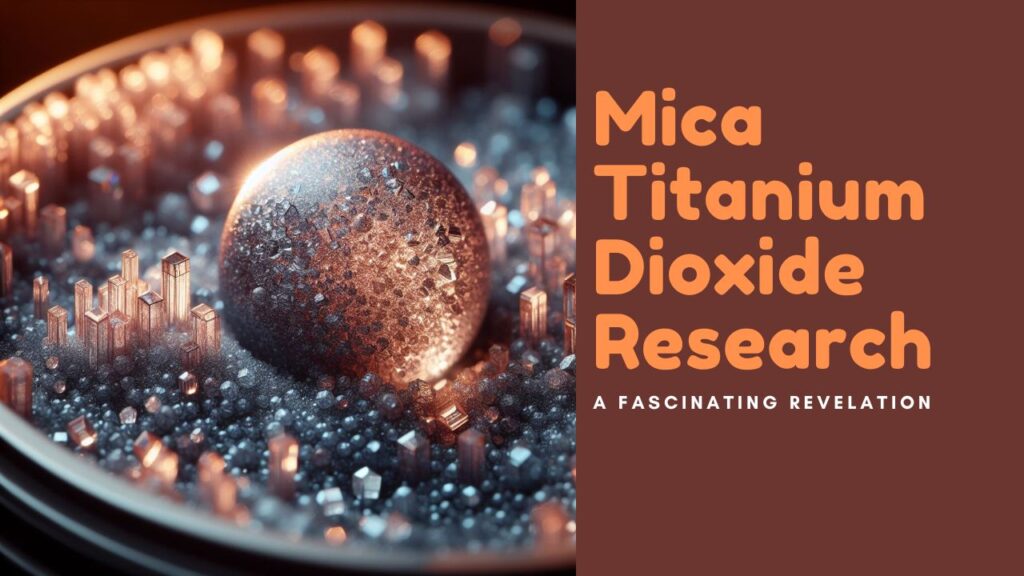Introduction of Mica Titanium Dioxide
Mica Titanium Dioxide (TiO2) stands at the forefront of innovation, with its versatile applications across various industries such as cosmetics, paints, and plastics. Recent breakthrough research in this field has unearthed captivating revelations, pushing the boundaries of what we thought was possible. Let’s delve into the significance of Mica Titanium Dioxide, and explore its chemical properties, applications, synthesis methods, and the profound impact of recent breakthroughs on industry and research.
Significance in Various Industries
Mica Titanium Dioxide plays a pivotal role in industries that rely on pigments, providing unique properties to the end products. In cosmetics, it imparts a shimmering effect, while in paints, it enhances opacity and brightness. Plastics benefit from its UV-blocking capabilities, preventing degradation. The compound’s versatility makes it a cornerstone in these sectors, influencing both aesthetics and functionality.
The recent breakthroughs in Mica Titanium Dioxide research have intensified its relevance. These breakthroughs go beyond traditional applications, opening new possibilities that were previously unexplored. Understanding the chemical composition and crystal structure is key to unlocking the full potential of this remarkable compound.
Chemical Properties and Structure of Mica Titanium Dioxide
Chemical Composition
Mica Titanium Dioxide is a composite material, that blends two key components: mica and titanium dioxide. Mica, a naturally occurring mineral, contributes a layered structure, imparting flexibility and sheen. Titanium dioxide, a white pigment, enhances opacity and brightness. The synergy between these components is the foundation of the compound’s unique characteristics.
Crystal Structure
The crystal structure of Mica Titanium Dioxide is complex, showcasing layers of mica interspersed with titanium dioxide particles. This layered arrangement contributes to the compound’s ability to refract light, creating a dazzling effect. The crystalline nature also influences its thermal stability and chemical resistance, making it suitable for a wide array of applications.
Role of Titanium Dioxide
Titanium dioxide acts as a reinforcing agent in Mica Titanium Dioxide. Its presence enhances the compound’s mechanical strength, UV-blocking capabilities, and opacity. This synergy is crucial for applications in cosmetics, where a subtle sparkle is desired, as well as in paints and plastics, where durability and protection against UV radiation are essential.
Understanding the intricacies of Mica Titanium Dioxide’s chemical properties lays the foundation for comprehending its applications across various industries.
Applications and Benefits
Wide Range of Applications
The applications of Mica Titanium Dioxide span multiple industries, each capitalizing on its distinct properties. In cosmetics, it is a staple for creating shimmering effects in eyeshadows, lipsticks, and nail polishes. Paints benefit from its opacifying properties, ensuring vibrant and long-lasting color. Plastics utilize their UV-blocking abilities, preventing degradation of the material in outdoor applications.
Unique Properties for Each Application
The unique properties of Mica Titanium Dioxide make it a sought-after ingredient in cosmetic formulations. Its ability to reflect and refract light imparts a subtle glow, adding a touch of glamour to various beauty products. In paints, the compound ensures uniform coverage, contributing to the longevity of the finish. Plastics infused with Mica Titanium Dioxide resist yellowing and degradation, extending the lifespan of products.
Examples of Specific Products
- Cosmetics: Mica Titanium Dioxide is extensively used in eyeshadows, providing a dazzling shimmer. A popular example is the Urban Decay Naked eyeshadow palette, where the compound enhances the pigments’ vibrancy and longevity.
- Paints: Premium interior paints, such as Benjamin Moore Aura, leverage Mica Titanium Dioxide for its opacifying effect. This ensures a rich and consistent color application, elevating the overall aesthetic of painted surfaces.
- Plastics: High-end outdoor furniture, like those made by Polywood, often incorporates Mica Titanium Dioxide in the manufacturing process. This inclusion enhances UV resistance, preventing discoloration and maintaining the product’s appearance over time.
Understanding the specific applications and benefits of Mica Titanium Dioxide provides insight into its widespread use and importance across diverse industries.
Synthesis and Manufacturing of Mica Titanium Dioxide

Methods of Synthesis
The synthesis of Mica Titanium Dioxide involves several steps to achieve the desired composition and properties. One common method involves the exfoliation of natural mica, followed by the deposition of titanium dioxide nanoparticles onto the mica layers. This process requires precise control over conditions such as temperature, pressure, and reaction time to ensure the formation of a uniform and stable composite.
Challenges and Advancements
Despite its widespread use, the manufacturing of Mica Titanium Dioxide comes with challenges. Achieving a consistent particle size distribution and preventing agglomeration are common hurdles. Breakthroughs in nanotechnology have played a crucial role in overcoming these challenges, allowing for more precise control over particle sizes and distribution.
Environmentally Friendly Approaches
Sustainability is a growing concern in manufacturing processes. Recent advancements in environmentally friendly approaches involve the use of green solvents, reducing energy consumption, and incorporating recycled materials. These strides contribute to a more sustainable and eco-friendly production of Mica Titanium Dioxide.
Understanding the synthesis and manufacturing processes sheds light on the complexities involved in bringing this compound from the laboratory to commercial applications.
Characterization Techniques
Analytical Techniques
Characterizing Mica Titanium Dioxide requires advanced analytical techniques to unveil its structural and chemical intricacies. Techniques such as X-ray diffraction (XRD) reveal crystal structures while scanning electron microscopy (SEM) provides detailed images of particle morphology. Fourier-transform infrared spectroscopy (FTIR) identifies chemical bonds, elucidating the composition.
Importance of Characterization
Accurate characterization is paramount for tailoring Mica Titanium Dioxide to specific applications. For instance, in cosmetics, knowing the particle size distribution ensures a smooth and even application, while in plastics, understanding the crystal structure aids in predicting UV-blocking efficiency. These techniques empower researchers and manufacturers to optimize the compound’s properties for diverse uses.
Examples of Characterization Methods
- X-ray Diffraction (XRD): This technique determines the crystal structure of Mica Titanium Dioxide. By analyzing the diffraction pattern of X-rays, researchers can precisely identify the arrangement of atoms within the compound.
- Scanning Electron Microscopy (SEM): SEM provides high-resolution images of the compound’s surface, revealing details about particle size and morphology. This aids in quality control during manufacturing.
- Fourier-Transform Infrared Spectroscopy (FTIR): FTIR is instrumental in identifying functional groups and chemical bonds present in Mica Titanium Dioxide. This information is vital for understanding the compound’s chemical stability and reactivity.
The importance of characterization techniques cannot be overstated, as they pave the way for tailoring Mica Titanium Dioxide to specific applications with precision.
Impact on Industry and Research

Potential Industry Impact
The recent breakthrough research in Mica Titanium Dioxide holds immense potential for industry advancement. The revelation of new properties or enhanced performance can lead to the development of superior products in cosmetics, paints, and plastics. This, in turn, can drive market competitiveness and innovation.
Advancements in Various Fields
The profound impact of breakthrough research extends beyond immediate applications. The enhanced understanding of Mica Titanium Dioxide’s properties may inspire innovations in related fields such as materials science, nanotechnology, and even medicine. Unexpected applications may arise, broadening the scope of this compound’s influence.
Future Research Directions
The recent breakthroughs also open avenues for future research. Exploring ways to further optimize the synthesis process, reduce environmental impact, or discover additional properties could be promising directions. Additionally, interdisciplinary collaborations might uncover novel applications in fields not traditionally associated with Mica Tio2.
Understanding the potential industry impact, advancements in various fields, and future research directions provides a holistic view of the transformative nature of recent breakthroughs in Mica Tio2 research.
Additional Context
Environmental Impact and Safety Considerations
The environmental impact of Mica Tio2 primarily relates to its synthesis and manufacturing processes. While the compound itself is generally inert and safe for use, the use of certain solvents and energy-intensive processes in manufacturing can contribute to environmental concerns. Sustainable approaches, as mentioned earlier, are addressing these issues, emphasizing the industry’s commitment to environmental responsibility.
Comparison with Other Titanium Dioxide Forms
Comparing Mica Tio2 with other forms, such as rutile and anatase, reveals distinct differences. Rutile is known for its excellent UV-blocking properties, while anatase excels in photocatalytic activities. Mica Tio2, with its layered structure and mica component, offers a unique combination of properties not found in other forms. This makes it particularly valuable in applications requiring a balance of aesthetics and functionality.
Regulatory Guidelines and Standards
Regulatory bodies, such as the U.S. Food and Drug Administration (FDA) and the European Chemicals Agency (ECHA), oversee the use of Mica Tio2 in cosmetics and other products. Compliance with established guidelines ensures the compound’s safety for consumers. Manufacturers must adhere to these standards to ensure the responsible and ethical use of Mica Tio2 in various applications.
Challenges in Commercialization
While Mica Tio2 presents numerous advantages, challenges in commercialization persist. These include the need for cost-effective manufacturing methods, ensuring a stable supply chain, and addressing potential environmental concerns. Overcoming these challenges is essential for the widespread adoption of Mica Tio2 across industries.
Risks and Benefits
The benefits of Mica Tio2, such as enhanced aesthetics, UV protection, and durability, must be weighed against potential risks. While the compound itself is generally safe, concerns may arise during manufacturing processes. Continued research and adherence to safety standards are crucial to mitigating any risks associated with its production and use.
Follow-up Questions
- Advancement of Sustainable Manufacturing Processes: The breakthrough research in Mica Tio2 contributes to sustainable manufacturing by addressing challenges in particle size distribution and agglomeration. This leads to more efficient use of resources, reducing environmental impact.
- Specific Cosmetic Products: Notable examples of cosmetic products utilizing Mica Tio2 include Fenty Beauty’s Killawatt Foil Freestyle Highlighter, where the compound contributes to a radiant finish, and NARS Radiant Creamy Concealer, where it enhances the concealer’s coverage and longevity.
- Factors in Selecting Characterization Techniques: Researchers consider factors such as the desired information (e.g., crystal structure, particle size), sample characteristics, and available equipment when selecting characterization techniques for studying Mica Tio2.
- Differences from Other Tio2 Forms: Mica Tio2 differs from rutile and anatase in its layered structure and mica component. This unique combination makes it suitable for applications where both aesthetics and functionality are crucial.
- Promising Future Research Directions: Future research in Mica Tio2 could focus on optimizing green synthesis methods, exploring medical applications, and delving into unexpected uses in fields beyond cosmetics, paints, and plastics.
In conclusion, Mica Tio2 stands as a testament to the intersection of science and industry, with breakthrough research paving the way for innovative applications and sustainable manufacturing practices. As we continue to unravel the mysteries of this compound, the possibilities for advancement and discovery seem boundless. Industries and researchers alike eagerly anticipate the next chapter in the captivating story of Mica Tio2.






Pingback: Mineral TiO2: The Best Secret You've Never Known - Safe Climber Overseas Pvt. Ltd.